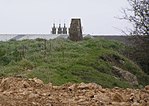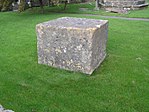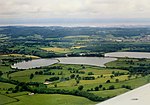Dundry
Civil parishes in SomersetUse British English from August 2012Villages in North Somerset

Dundry is a village and civil parish, situated on Dundry Hill in the northern part of the Mendip Hills, between Bristol and the Chew Valley Lake, in the English county of Somerset. The parish includes the hamlets of Maiden Head and East Dundry. The parish had a 2011 population of 829.The village lies on the route of the Monarch's Way long-distance footpath. It is a popular destination for the people of Bristol as it is known for its panoramic views of the city.
Excerpt from the Wikipedia article Dundry (License: CC BY-SA 3.0, Authors, Images).Dundry
Crabtree Lane,
Geographical coordinates (GPS) Address Nearby Places Show on map
Geographical coordinates (GPS)
| Latitude | Longitude |
|---|---|
| N 51.3957 ° | E -2.6389 ° |
Address
Crabtree Lane
BS41 8LN
England, United Kingdom
Open on Google Maps











